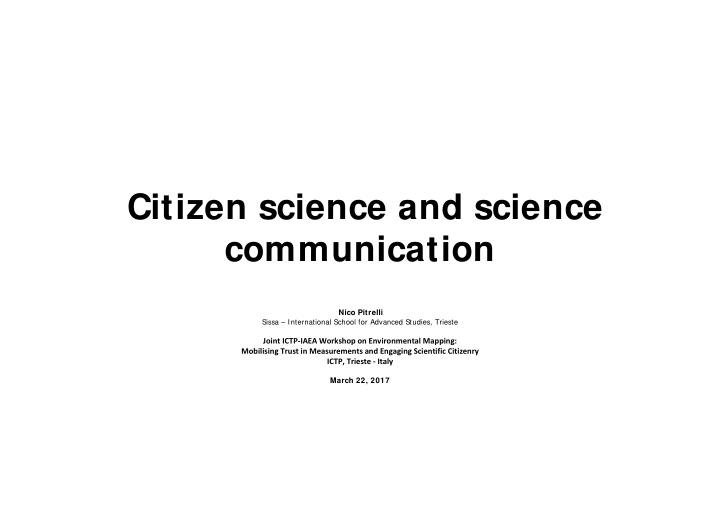



Citizen science and science communication Nico Pitrelli Sissa – International School for Advanced Studies, Trieste Joint ICTP ‐ IAEA Workshop on Environmental Mapping: Mobilising Trust in Measurements and Engaging Scientific Citizenry ICTP, Trieste ‐ Italy March 22, 2017
What is the place of citizen science in the ecosystem of public communication of science?
What is citizen science ?
Citizen Science refers to the general public engagement in scientific research activities when citizens actively contribute to science either with their intellectual effort or surrounding knowledge or with their tools and resources. SOCIETIZE CONSORTIUM, 2013, P . 6
C ontributory citizen science
Democratized citizen science
Scientific literacy Public Communication Scientists
Radioactive sheep «crisis»
Lay knowledge is not an impoverished or quantitatively inferior version of expert knowledge; it is qualitatively different
Kahan et al., 2012: Contrary to deficit model predictions, Kahan et al., 2012: Contrary to deficit model predictions, higher degrees of science literacy and numeracy highly science-literate and numerate hierarchical individualists are associated with a small decrease in the perceived are more sceptical, not less, of climate change risks.. seriousness of climate change risks. “The public divisions over climate change stem not from public’s incomprehension of science, but from the agreement with the dominant view of their cultural group” 10
Knowledge is filtered by way of an individual’s social and political identity
Some points • Citizen science is about the relationship between science, democracy and expertise; • The different strands of citizen science can come together; • Citizen science has dramatically expanded through the use of the Internet and digital technologies.
What is the role of communication in citizen science ?
Science communication is built in citizen science projects: • To recruit participants; • To explain the scientific process; • To present the results.
Motivation, education, democracy
IThe ladder of citizen participation IThe ladder of citizen participation
Some results from research at the intersection of citizen science and science communication • Citizen science succeeds when it is real science; • One kind of learning that citizen science offers is not about science, but about citizenship; • The shift to digital forms of citizen science shows more clearly that the demarcation line between certified experts (professional scientists) and lay people (non-scientists) is blurring;
Digital media enable new social inclusion spaces for both production that for the appropriation and assessment of knowledge
Science outside institutions The biohackers represent a bottom-up approach to science that combine practices of amateur marginalized amateur research with current trends towards Open Science, Open Source, Open Data
New online platforms to evaluate and discuss scientific publications
«The digital world brings new forms of co-construction of knowledge, which include a broad range of people regardless of their professional affiliation to the system of production, appropriation and assessment of knowledge» Dickel, S. and Franzen, M. (2016). ‘The “Problem of Extension” revisited: new How to cite modes of digital participation in science’. JCOM 15 (01), A06_en
OUR MORE GENERAL AI M “The book’s central proposition is that educators and researchers can be much more effective if they know more about how people think and learn about science” Luigi Ceccaroni and Jaume Piera (2016) (eds.), Analyzing the Role of Citizen Science in Modern Research , Information Science Reference, pp. XX
Bibliographical references -M. Bucchi and B. Trench (2014) (eds.), Handbook of Public Communication of Science and Technology. Second Edition , Routledge; -Cavalier, D. and Kennedy, E. B. (2016) (eds.), The Rightful Place of Science: Citizen Science , Consortium for Science, Policy, & Outcomes -Ceccaroni, L. and Piera, J. (2016) (eds.), Analyzing the Role of Citizen Science in Modern Research , Information Science Reference -Dickel, S. and Franzen, M. (2016). ‘The “Problem of Extension” revisited: new modes of digital participation in science’. JCOM 15 (01), A06_en -Epstein S. (1996), Impure Science; AIDS, activism, and the politics of knowledge , University of California Press USA 1996 -Kahan D. M., Ellen Peters, Maggie Wittlin, Paul Slovic, Lisa Larrimore Ouellette, Donald Braman and Gregory Mandel (2012), The polarizing impact of science literacy and numeracy on perceived climate change risks , Nature Climate Change 2, 732–735 -Irwin, A. (2014), “Risk, science and public communication: Third-order thinking about scientific culture”, in M. Bucchi, & B. Trench (Eds.), Handbook of Public Communication of Science and Technology. (pp. 160-172). Routledge -Nowotny, H., Scott, P ., Gibbons, M. (2001), Re-thinking science. Knowledge and the public in an age of uncertainty , Cambridge, Polity -Lewenstein, B.V . (2016), “Can we understand citizen science?”, JCOM 15(01), E. -Wynne, B. (1999), Sheepfarming after Chernobyl: a case study in communicating scientific information , "Environment magazine", 31, 1989, pp. 10-15, 33-39 -Wynne, B. (1992), ”Misunderstood misunderstanding: Social identities and public uptake of science”, Public Understanding of Science 1: 281-304.
Recommend
More recommend